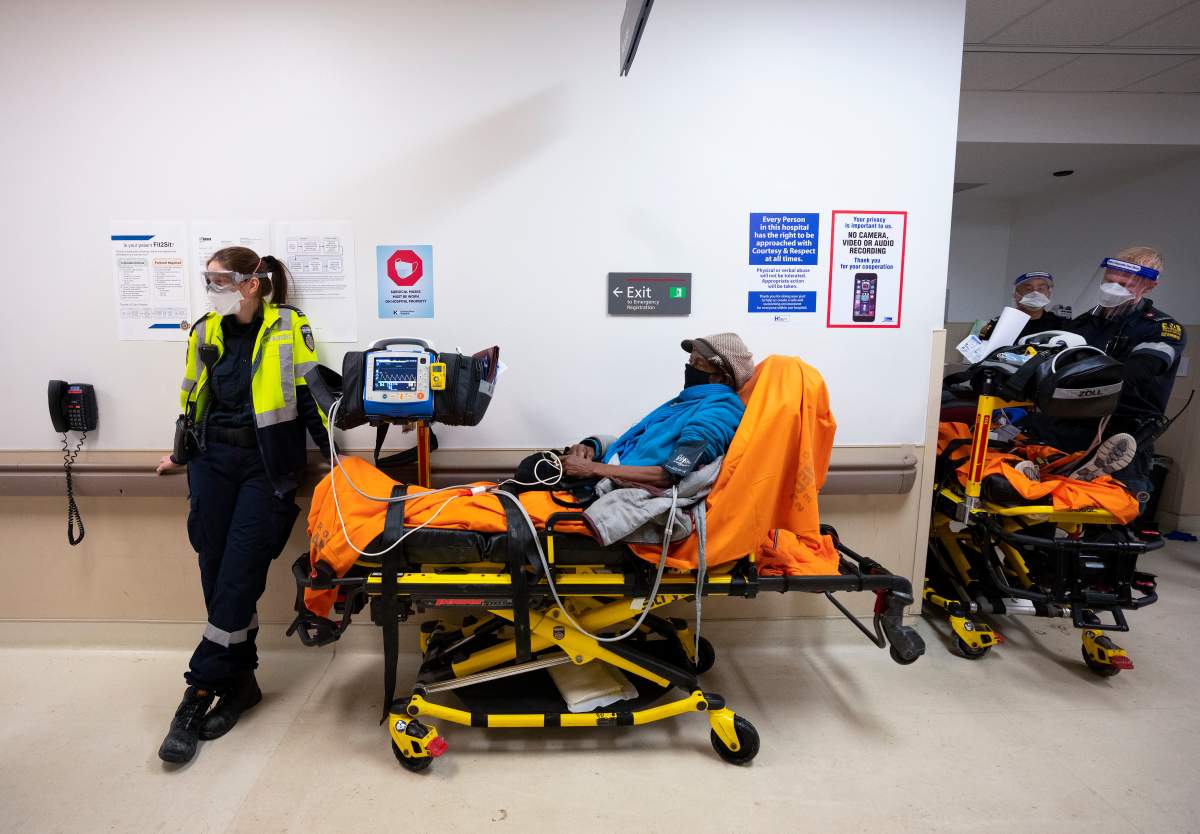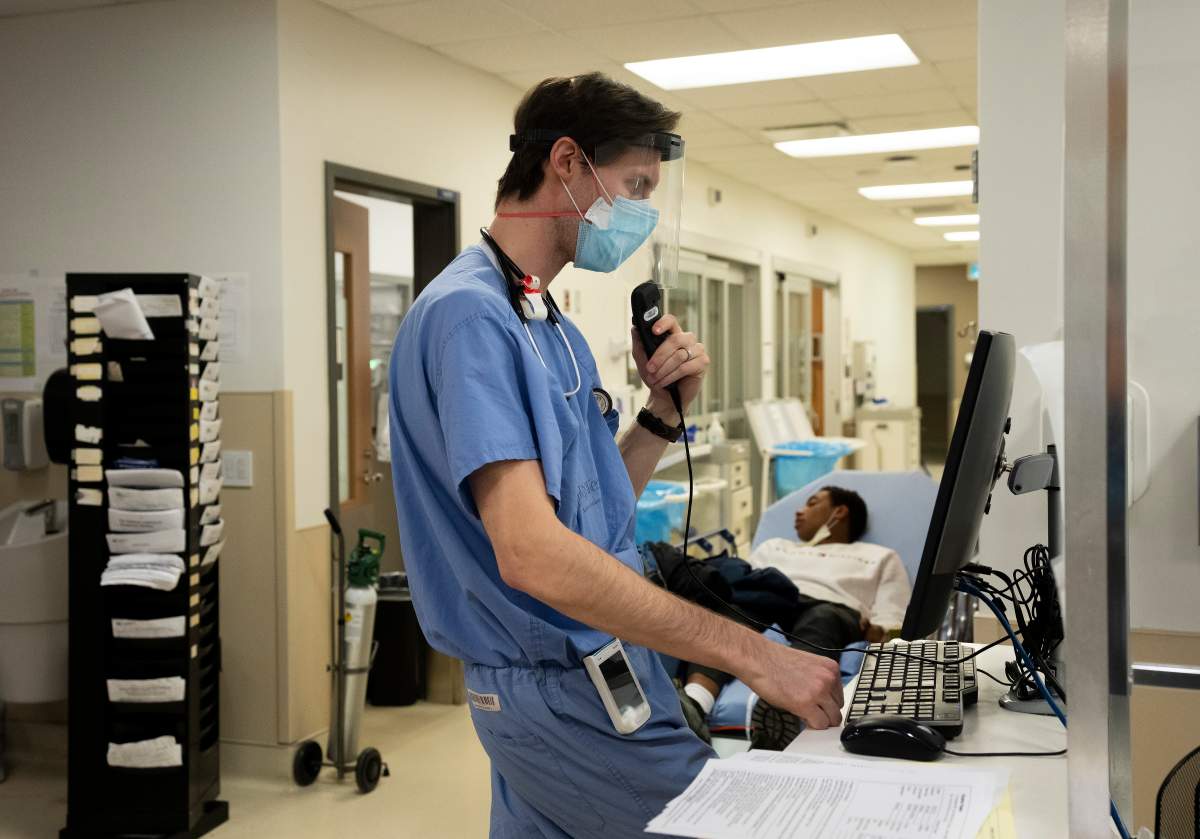TORONTO — Eight patients on gurneys line a hallway of a Toronto emergency department one Tuesday afternoon in January. Three more rest down another hall.

“Help me, help me,” a patient moans.
“Lady, be quiet!” another yells back.
The emergency department at Humber River Hospital is full. All 72 rooms are occupied. Thirty per cent of patients there have COVID-19, says Jane Casey, director of the emergency department and a registered nurse.
Even before the pandemic, it was one of the busiest emergency departments in the province, she says, and they see, by far, the most ambulances in Ontario. But the Omicron variant has filled the ER to the brim, creating logistical issues and leading to longer wait times for patients.
In the acute care unit of the emergency department, Dr. Olivier Lavagueur scans a computer, surveying the situation. A woman screams in the background. A nurse heads over to check on her.
“On my screen, there’s a whole bunch of patients to be seen,” Lavagueur says.
“It’s been more difficult to actually get rooms to see our patients because everything is becoming kind of logjammed.”
He says they’ve thought about different ways to treat patients who do not have a room.
“The question remains: should you try and see them in the hallway or should you try to see them in the ambulances?” Lavagueur says. “That just becomes dangerous because you’re just not doing a good job.”
Staff are also dealing with patients coming in with both COVID-19 symptoms and other medical problems.

Get weekly health news
If a patient shows symptoms, staff assume they have the virus, but they also take a swab and run an in-hospital PCR test. Results take about two hours to come back, Casey says, further adding to wait times.
And figuring out where to put someone, who, say, has a hernia, but also tests positive is complicated.
“It’s very tricky. It’s a lot of logistics trying to figure out where to send someone because they can’t just go anywhere in the hospital. We have COVID-specific wards,” Lavagueur says.
The disease has shown to complicate matters for those coming in for a different medical episode, Lavagueur explains.
“It can definitely make everything worse,” he says. “It’s just an added stressor on your body.”
The Omicron variant has led to more complex medical cases, which in turn leads to longer hospital stays, Casey says.

“If you come in with COVID and all these other concerns and you need to be admitted upstairs, you just stay longer,” Casey says. “You’re often here longer just because it takes longer to care for you.”
Despite the ER being full, the overall number of patients they’re seeing during the fifth wave is actually down, Casey says.
Lavagueur says that is due to fewer patients coming into the emergency department with minor injuries like cut and sprains.
“I think we’ve seen a lot less of those patients because people are afraid to go to emergency, and rightfully so,” he says. “There’s lots of patients with COVID _ the present variant is very contagious.”
It’s not just beds that are hard to come by, it’s people to staff them, too.
Like the rest of the health-care system in the province, Humber River Hospital has also dealt with staffing shortages during the fifth wave of the pandemic.
Before Omicron came to town, they lost staff to the United States and nurses heading north to work, Casey says.
The highly transmissible variant then wreaked havoc among staff in late December and early January, either through direct infection or the need to quarantine following an exposure.
Those who caught COVID-19 could return to work after seven days if they were symptom-free, she says, but 10 days if they had symptoms or had an exposure.
“Staff are tired,” she says. “They’ve worked a lot lately.”

In early January, the hospital welcomed more than 1,000 nursing students to bolster their ranks.
“We’ve had some creative solutions for our staffing,” Casey says.
Thirty-six of those students in their final semester have come in as reinforcements to the emergency department.
“We have not done that before,” she says. “My hope is that many of them are future (ER) nurses and we will be able to hire them at the end.”
The doctors are also tired two years into the pandemic, but they press on by helping each other out, Lavagueur says.
Still, it’s been a long two years for him.
When COVID-19 hit Canada in early 2020, Lavagueur’s wife was pregnant. With all the uncertainty about the disease at the time, he moved out for a month. He worried he’d pick up the virus at work and give it to her.
“It was pretty brutal,” he says. “It takes a toll on your mental health, for sure.”
He moved to work at Humber River Hospital this past November when COVID-19 case counts were low.
“It was pretty sweet,” he says. “Things were dying down, there might be other wavelets, but it’ll be fine, I thought.”
Then Omicron hit.
“It just feels like it’s endless,” Lavagueur says.
He knows he needs to take a step back at some point for the good of his mental health, but that’s not possible right now with the emergency department overflowing.
“There’s a huge workload and lots of your friends, lots of your colleagues ended up being ill and you need to pick up the slack too _ it’s a horrible combination,” he says with a laugh.
“It is what it is.”









Comments